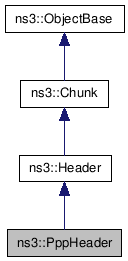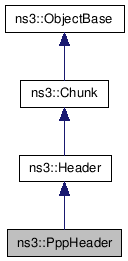ns3::PppHeader Class Reference
Packet header for PPP. More...
#include <ppp-header.h>


Public Member Functions | |
| PppHeader () | |
| Construct an IP version 4 PPP header. | |
| virtual | ~PppHeader () |
| Destroy an IP version 4 PPP header. | |
| virtual TypeId | GetInstanceTypeId (void) const |
| virtual void | Print (std::ostream &os) const |
| virtual void | Serialize (Buffer::Iterator start) const |
| virtual uint32_t | Deserialize (Buffer::Iterator start) |
| virtual uint32_t | GetSerializedSize (void) const |
Static Public Member Functions | |
| static TypeId | GetTypeId (void) |
| This method returns the TypeId associated to ns3::PppHeader. | |
Detailed Description
Packet header for PPP.This class can be used to add a header to PPP packet. Currently we do not implement any of the state machine in RFC 1661, we just encapsulate the inbound packet as an IP version 4 type and send it on. The goal here is not really to implement the point-to-point protocol, but to encapsulate our packets in a known protocol so packet sniffers can parse them.
if PPP is transmitted over a serial link, it will typically be framed in some way derivative of IBM SDLC (HDLC) with all that that entails. Thankfully, we don't have to deal with all of that -- we can use our own protocol for getting bits across the serial link which we call an ns3 Packet. What we do have to worry about is being able to capture PPP frames which are understandable by Wireshark. All this means is that we need to teach the PcapWriter about the appropriate data link type (DLT_PPP = 9), and we need to add a PPP header to each packet. Since we are not using framed PPP, this just means prepending the sixteen bit PPP protocol number (0x0021) to the packet. The ns-3 way to do this is via a class that inherits from class Header.
Member Function Documentation
| virtual uint32_t ns3::PppHeader::Deserialize | ( | Buffer::Iterator | start | ) | [virtual] |
- Parameters:
-
start an iterator which points to where the header should written.
- Returns:
- the number of bytes read.
Implements ns3::Header.
| virtual TypeId ns3::PppHeader::GetInstanceTypeId | ( | void | ) | const [virtual] |
- Returns:
- the TypeId associated to the most-derived type of this instance.
Implements ns3::ObjectBase.
| virtual uint32_t ns3::PppHeader::GetSerializedSize | ( | void | ) | const [virtual] |
- Returns:
- the expected size of the header.
Implements ns3::Header.
| static TypeId ns3::PppHeader::GetTypeId | ( | void | ) | [static] |
This method returns the TypeId associated to ns3::PppHeader.
No Attributes defined for this type.
No TraceSources defined for this type.
Reimplemented from ns3::Header.
| virtual void ns3::PppHeader::Print | ( | std::ostream & | os | ) | const [virtual] |
This method is used by Packet::Print to print the content of a trailer as ascii data to a c++ output stream. Although the trailer is free to format its output as it wishes, it is recommended to follow a few rules to integrate with the packet pretty printer: start with flags, small field values located between a pair of parens. Values should be separated by whitespace. Follow the parens with the important fields, separated by whitespace. i.e.: (field1 val1 field2 val2 field3 val3) field4 val4 field5 val5
Implements ns3::Header.
| virtual void ns3::PppHeader::Serialize | ( | Buffer::Iterator | start | ) | const [virtual] |
- Parameters:
-
start an iterator which points to where the header should be written.
Implements ns3::Header.
The documentation for this class was generated from the following files:
- src/devices/point-to-point/ppp-header.h
- doc/introspected-doxygen.h
 1.5.8
1.5.8